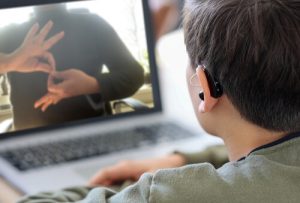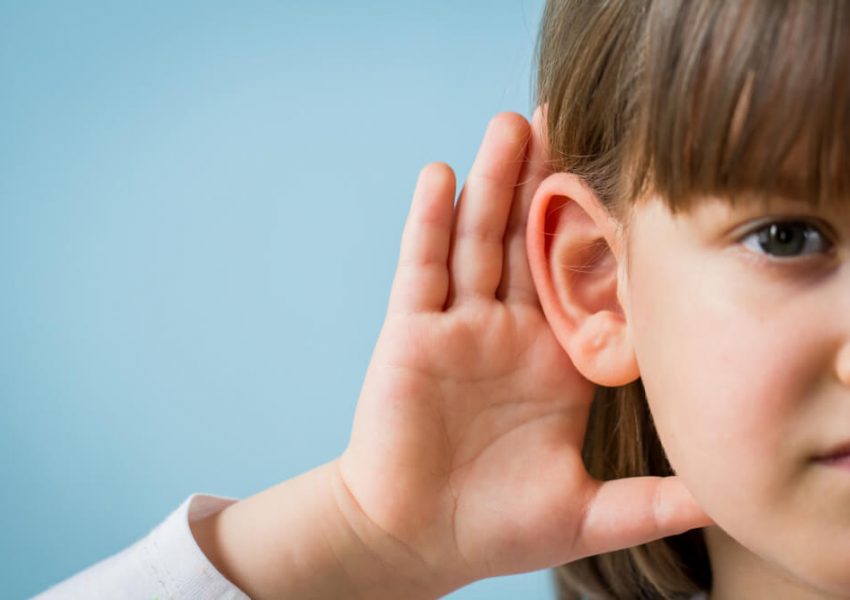There is no “one-size-fits-all” approach to communication simply because there is no “typical” deaf person. Each individual is unique and brings their own set of communication needs and preferences based on the interaction’s setting and purpose. Determining how deaf people communicate effectively is a joint effort shared by both the deaf individual and the hearing individual.
Deafness: The Importance of Communication
The ability to communicate defines us as human beings and as a society. It forms a foundation for decision-making and relationship-building. Interacting with deaf individuals is an achievable goal, even when accommodations (e.g., interpreters) are not present. The tools available are considerable and limited only by our desire to communicate and our creativity.
Ways for the Deaf to Communicate
If you experience hearing loss, it makes it more difficult to communicate with people around you. If you see an audiologist, they can fit you with hearing aids to improve your hearing and alleviate those communication difficulties. However, when people lose their hearing entirely, they cannot rely on hearing aids to help them communicate. A deaf person converses in two main ways – sign language and lip reading.
Lip Reading
 Anybody can experience hearing loss at any point in their lives, but you have a greater risk as you age. When your hearing ability diminishes, you may see an audiologist and use hearing aids. However, as your hearing declines further, hearing aids will not always be effective, and you may need to find other ways of understanding people, which is where lip reading comes in.
Anybody can experience hearing loss at any point in their lives, but you have a greater risk as you age. When your hearing ability diminishes, you may see an audiologist and use hearing aids. However, as your hearing declines further, hearing aids will not always be effective, and you may need to find other ways of understanding people, which is where lip reading comes in.
If somebody becomes deaf later in life, it is easier for them to interpret speech through lip reading by analysing the movement of the lips and tongue. Facial expressions and body language are also important parts of lip reading because they help a deaf person to understand the tone of what is being said and the emotion behind those words.
Lip readers also pay attention to the context of the conversation because this narrows down vocabulary and helps to differentiate between words. There are a lot of words that sound the same and are made using the same mouth movements. This means that only around 30% of words in the English language can be accurately differentiated, even by the most experienced lip reader. But understanding the context of the conversation helps them to work out which word you are using. For example, if you are talking about the weather, the person says sun, not son.
If a person still has some residual hearing with the help of hearing aids, these sounds can also help them to make lip reading more accurate.
Learning to lip read takes a lot of practice, especially for somebody that was born deaf or lost their hearing at an early age. If you seek advice from an audiologist, they will be able to help you find some lip-reading classes.
Sign Language
 Sign language is considered one of the most important methods of communication for deaf individuals, as it provides a medium through which they can express themselves clearly. This language requires two hands, which are used to form symbols that represent words and phrases. Hand motions that are associated with sign language often represent entire sentences or ideas – each gesture conveys a different meaning that takes context into account.
Sign language is considered one of the most important methods of communication for deaf individuals, as it provides a medium through which they can express themselves clearly. This language requires two hands, which are used to form symbols that represent words and phrases. Hand motions that are associated with sign language often represent entire sentences or ideas – each gesture conveys a different meaning that takes context into account.
The signs used in sign language vary between countries and regions, though all contain common elements, including facial expressions and body movements. In the United States, American Sign Language (ASL) is one of the most popular forms of sign language and consists of more than 3,000 signs. Other notable types include British Sign Language (BSL), French Sign Language (LSF), Chinese Sign Language (CSL), Italian Sign Language (LIS), German Sign Language (DGS) and many others. Each type has its own set of rules, syntaxes and gestures that must be mastered to communicate properly.
Use of Technology
In addition to sign language, new technological solutions have been created to help deaf people communicate more easily with those who do not use sign language or understand spoken languages. These solutions range from simple text-to-speech devices to multi-language translation services like Skype Translator. Some devices also offer visual displays that allow users to view communications translated into written words or symbols on a computer screen or smartphone app.
Tips in Communication
Deaf people can easily avoid communication barriers if they follow these helpful tips:
- Book an interpreter. Patients should not use a friend or family member to interpret for them. They will not know medical jargon or be trained to analyze health information. Still, most importantly, your patient will have no independence or privacy if a friend or family member accompanies them.
- Talk directly to your patient, not the person interpreting for them.
- Make sure you have your patient’s attention before talking. The patient will need to be able to see the interpreter.
 Maintain eye contact whilst communicating. Don’t talk to your patient whilst looking at your computer screen, filling out paperwork, or turning around. Avoid covering your mouth with your hands or paper.
Maintain eye contact whilst communicating. Don’t talk to your patient whilst looking at your computer screen, filling out paperwork, or turning around. Avoid covering your mouth with your hands or paper.- Use normal lip movement. You don’t need to over-exaggerate each word, and don’t mumble, because this can make it difficult to lip-read.
- Speak at a normal volume. Shouting can be uncomfortable for a patient wearing hearing aids.
- Make sure the room is well-lit so the patient can see your face clearly.
- Speak in plain English at a normal speed.
- Use written notes or diagrams to assist if you are having difficulty explaining something. But remember that deaf people have different communication needs, so noting information down won’t be helpful for everyone. If your patient doesn’t understand you, try and think of another way to explain yourself rather than repeating the same words again.
- Use gestures and facial expressions to help explain yourself. Show with your face if something is painful, scary, or nothing to worry about.
- Point to parts of your body if necessary.
- Keep checking to make sure your patient understands you. If your patient doesn’t understand you, try and think of a different way to explain yourself.
On the other hand, it would be easier to converse and interact with a deaf friend or relative if you follow these tips:
- Get the attention of the deaf individual before speaking. If the individual does not respond to the spoken name, a tap on the shoulder or another visual signal is appropriate.
- Provide a written outline of the main topics to be discussed. This is especially helpful for individuals who depend on speech reading to pick up on keywords in a conversation.
- Speak clearly and at a normal pace; do not yell or over-enunciate.
- Look directly at the individual while speaking.
- Do not cover your mouth or look around while speaking.
- Avoid standing in front of a light source, which can make it difficult to see your face clearly.
- If you need to repeat, rephrase the thought. Some words are harder to understand than others; rephrasing allows for opportunities to understand what was previously missed.
- Use visual aids, gestures, and body language when appropriate. The old saying that one picture is worth a thousand words is true.
- Do not be afraid to use pen and pencil or texting as a tool.
- Use open-ended questions to allow for more opportunities for both parties to check each other’s understanding of a topic.
References:
https://signhealth.org.uk/resources/learn-about-deafness/tips-for-communicating-with-deaf-patients/
https://www.usf.edu/student-affairs/student-accessibility/documents/com-deaf-individuals.pdf
https://www.hearingdogs.org.uk/deafness-and-hearing-loss/how-deaf-people-communicate/


